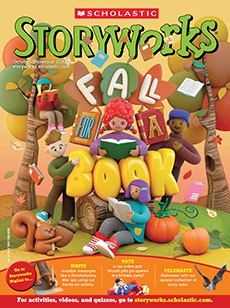Work with students in a small group to come up with a chronological list of the important events in the article. Then have them record themselves retelling what happened, using the list as a guide.

The Wild Life of Christian the Lion
In the 1960s, two young Australians bought a lion cub from a London department store—and an incredible interspecies friendship began. Paired with an original poem from Rebecca Kai Dotlich, this amazing true story explores our relationship with wild animals.
Learning Objective: Students will identify the theme that connects a nonfiction article and a poem.
More About the Story
Skills
Theme, vocabulary, text features, inference, text evidence, key details, interpreting text, setting, narrative writing
Complexity Factors
Purpose
“The Wild Life of Christian the Lion” recounts the journey of a young lion from captivity in a department store to freedom in Kenya, thanks to two men determined to return the animal to a natural life. “Wild Home" is a poem expressing the idea that lions should be free.
Structure
The first text is mainly a chronological narrative of the lion’s life. The poem has nine non-rhyming lines.
Language
The article includes some challenging academic and domain-specific vocabulary (e.g. betray, predator, captivity). The poem has challenging vocabulary dealing with a lion's African habitat (e.g. acacia, kapok, savanna).
Knowledge Demands
The article takes place in London and Kenya.
1. Preparing to Read
Preview Text Features and Vocabulary (20 minutes, activity sheet online)
- Ask students to examine the photo, headline, and subhead on page 15 and make a prediction about what the article will be about. Point out the poem on page 19 and ask students to identify clues about how it will relate to the article. (Students will probably notice that, like the article, the poem has “wild” in the title and a photo of a lion.)
- Show the vocabulary slideshow or distribute the vocabulary activity to preview challenging words. Highlighted words: flocked, predator, prowl, betray, captivity, venture, marveling, untethered
- Call on a student to read aloud the Up Close box on page 16 for the class.
2. Close Reading
Read and Unpack the Text (45 minutes, activity sheet online)
Read the article as a class or in groups. Then have groups answer the close-reading questions.
Read the poem as a class and discuss the close-reading questions. Explain that acacia and kapok are types of trees that grow on the African savanna—or open grassland with scattered trees.
Discuss the critical-thinking questions as a class.
“The Wild Life of Christian the Lion”
- Reread the first section of the article. Why do you think Ace and John bought the lion cub at Harrods? (inference) The article says that Ace and John saw the little lion “trapped” in a cage, and that they couldn’t stop thinking about him. It seems that the men didn’t want the cub to live in a cage, so they bought him to give him more freedom.
- In “Growing Up,” the text says that “London was no place for Christian.” Which details support this? (text evidence) Christian would eventually grow to weigh 500 pounds and have sharp claws and fangs; it wouldn’t be safe to keep him around people in a city. Also, lions roam thousands of acres in the wild; Christian would have no place to prowl in London.
- Why do you think John says that putting Christian in a zoo would “betray” him? (theme) John and Ace had bought Christian so they could let him out of a cage. If they put him in a zoo, they would be returning him to a cage and taking away his chance to be free.
- What challenges did Ace and John face in trying to set Christian free? (key details) First, the men didn’t know where they could free him. After they made arrangements to take him to Kenya, Christian had to learn the skills he would need to live in the wild, like stalking prey and defending himself. Christian still had tame habits, like sleeping on a cot.
- Reread the last paragraph. What feelings can you infer John and Ace had as they left Christian? (inference) You can infer that they felt sad for themselves because they would miss Christian, but they were content because they had done the best thing for Christian: set him free.
"Wild Home"
- In the first line of the poem, who are “they”? How do you know? (interpreting text) “They” are lions. The line goes on to describe their manes and activities lions would do. Also, a photo of a lion accompanies the poem.
- Which words in the poem help create the image of a lion’s habitat in Africa? (setting) Words include watering holes, acacia, kapok, star grass, sunbirds, weavers, and savanna skies.
- According to the poem, where do lions belong? (key details) They belong at watering holes, grazing in star grass, under the white moon, and in other places that are free. They belong with other lions.
- What theme, or big idea, do the article and poem share? (theme) Both the article and the poem share the theme that wild animals belong in their natural habitats, free to behave as nature intended. The article describes how Ace and John release a lion from captivity to a natural life in the wild. The poem emphasizes that lions belong “free and untethered and wild as savanna skies.”
- Both the article and poem use the words roam or roamers. What does roam mean? How does it relate to the theme of the texts? (theme) Roam means to wander freely. The word relates to the theme because in the wild, lions roam many miles a day. The article states that Christian and his new pride were “roaming all day” and “Christian was free to roam the wild like his ancestors.” The poem imagines lions “joining fellow roamers day and night.” Both texts embrace this natural habit.
3. Skill Building
Featured Skill: Theme
Distribute our theme activity, which will guide students to analyze the theme in both texts and prepare them to respond to the writing prompt on page 19.
Show a YouTube Video Show students the original footage of John and Ace’s reunion with Christian in an early viral YouTube video. Find it at www.youtube.com/watch?v=md2CW4qp9e8. (Be sure to preview the video for inappropriate ads or comments.) Follow up with a discussion of whether the article and video changed students’ ideas about animals, and if so, how.
Have students research the life of lions in captivity compared with those living in the wild. Ask them to work in groups to share their findings, then hold a debate on the pros and cons of keeping lions in zoos.
Have students make a list of words to describe Christian in the photo on page 15. Provide support as necessary. Words might include sweet, furry, lovable, calm, etc. Do the same with the photo at the bottom of page 18.
Have small groups read the article, imagining they are Ace and John. Ask them to pause at the end of each section to discuss their thoughts and feelings about Christian, and what motivates their actions.
